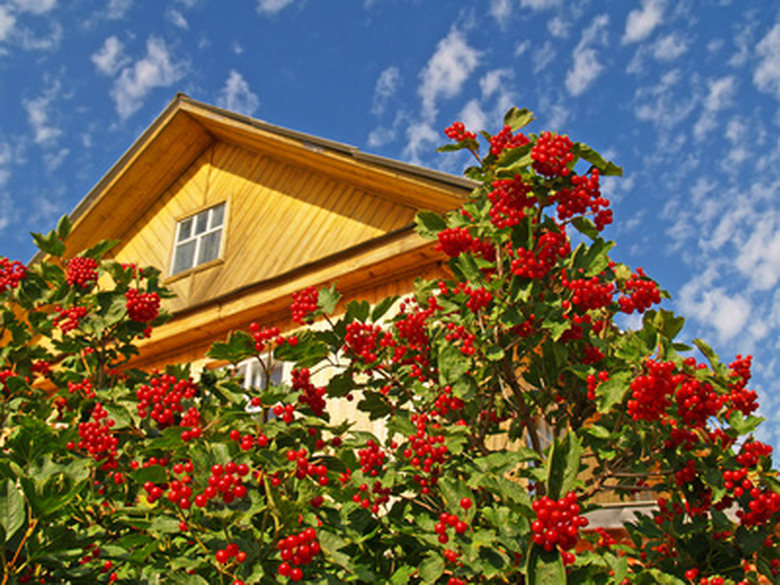Viburnum Diseases
Viburnum, also known as nannyberry or American cranberry bush, grows as a shrub or small tree. Native to the eastern United States and hardy through U.S. Department of Agriculture Zone 2, viburnum's attractions include glossy, dark-green leaves and clusters of white flowers. In the fall, the flowers give way to bright berries that change hues, going from green to yellow to red and then black. Viburnum is resistant to many serious diseases, although some fungi and bacteria can attack the species.
Leaf Spot
Various fungi, including the anthracnose fungus, can cause viburnum leaves to develop black, sunken lesions. The lesions can spread across the leaf surface and eventually dry up and turn red or grayish-brown. Joey Williamson, Clemson University Horticulture Extension agent, says fungal leaf spots are a common, but usually not serious, issue for viburnum, especially during periods of high humidity or rainfall. Williamson advises planting viburnum far enough apart to provide good air circulation around the leaves.
- Viburnum, also known as nannyberry or American cranberry bush, grows as a shrub or small tree.
- Various fungi, including the anthracnose fungus, can cause viburnum leaves to develop black, sunken lesions.
In addition, to guard against leaf spot, avoid watering the plants from above to keep leaves as dry as possible. Pluck off diseased leaves still on the plants and dispose of fallen leaves to keep the disease from spreading. Fungicide sprays that contain chlorothalonil, thiophanate-methyl, myclobutanil or mancozeb also can help control leaf spot.
Powdery Mildew
Another fungal disease, powdery mildew attacks new leaves and shoots, leaving behind a white or grayish powder on the upper surface of leaves. Watch for this disease in summer, when the conditions ideal to its development—high humidity, warm days and cool nights–exist. If it progresses, powdery mildew can deform leaves. Follow the same precautions used to prevent leaf spot, Clemson's Williamson advises. Myclobutanil, triadimefon, triforine or horticultural oil are among the fungicides that can control powdery mildew.
- In addition, to guard against leaf spot, avoid watering the plants from above to keep leaves as dry as possible.
Downy Mildew
Downy mildew appears both as light green lesions or blotches on the upper leaf surfaces and a white powder on the lower leaf surfaces, according to the Ohio State Extension service. The lesions turn red and then brown, then dry out. The disease can cause leaves to drop off the viburnum. The powdery mildew fungus prefers wet conditions and cool or warm weather. Since the mildew spores can survive through the winter, gardeners should clean up any fallen leaves or plant debris regularly. A fungicide containing mancozeb or chlorothalonil is effective against downy mildew.
Bacterial Blight
Various strains of Pseudomonas syringae cause this disease. The symptoms include small black spots or large brown spots on leaves, blackened leaf veins and dead blossoms and stem tips. Some plants may develop stem lesions or cankers that ooze liquid. Blight bacteria prefer wet conditions, including rainy springtime weather. Proper spacing and regular pruning can help prevent bacterial blight.
- Downy mildew appears both as light green lesions or blotches on the upper leaf surfaces and a white powder on the lower leaf surfaces, according to the Ohio State Extension service.
- Since the mildew spores can survive through the winter, gardeners should clean up any fallen leaves or plant debris regularly.
To keep the disease from spreading, cover small plants with plastic, the University of California's Integrated Pest Management Program (IPM) advises. Sprays are not effective against the disease, according to IPM.
